
Beechcraft Model YC-43 (D17S) 17 Staggerwing – N295BS / 39-139 – Flying Legends Airshow 2012 Duxford. The Beechcraft Model 17 Staggerwing is an American biplane with an atypical negative stagger (the lower wing is further forward than the upper wing), that first flew in 1932. At the height of the Great Depression, aircraft executive Walter H. Beech and airplane designer T. A. “Ted” Wells joined forces to collaborate on a project many considered foolhardy – a large, powerful, and fast biplane built specifically for the business executive. The Beechcraft Model 17, popularly known as the “Staggerwing” was first flown on November 4, 1932, setting the standard for private passenger airplanes for many years to come. It was considered, during its time, to be the premier executive aircraft flying, much as the private jet is considered in contemporary times. (Photo by Rob Lovesey)

The Flying Bull's P-38 Lockheed Lightning N25Y / 13 – Red Bull – Flying Legends Airshow 2012 Duxford. (Photo by Rob Lovesey)

The Fighter Trio - North American P-51D Mustang “Miss Velma” D-CY and Supermarine Spitfire Supermarine 509 Spitfire T9C – G-CCCA/QVI – Flying Legends Airshow Duxford 2012 (Photo by Rob Lovesey)

Sikorsky S-38B Replica N28V – Osa's Ark – Flying Legends Airshow Duxford 2012. The Sikorsky S-38 was an American twin-engined 8-seat amphibious aircraft. It was sometimes called “The Explorer's Air Yacht” and was Sikorsky's first widely produced amphibious flying boat which in addition to serving successfully for Pan American Airways and the U.S. Army, also had numerous private owners who received notoriety for their exploits. The S-38 was developed from the Sikorsky S-34 and S-36. The S-38 first flew on May 25, 1928. The United States Navy ordered two aircraft (designated XPS-2) and Pan American Airways were an early customer. A total of 101 aircraft were built, manufactured originally by the Sikorsky Manufacturing Corporation of Long Island, New York, and by the Sikorsky Aviation Corporation in Bridgeport, Connecticut. Sikorsky was acquired by United Aircraft and Transport Corporation (now United Technologies Corporation) in mid-production. (Photo by Rob Lovesey)

Fairey Swordfish Mk II – LS326 Royal Navy Historical Flight – Flying Legends Airshow Duxford 2012. (Photo by Rob Lovesey)

Consolidated PBY-5A Catalina G-PBYA / 433915 – Flying Legends Airshow Duxford 2012. The Consolidated PBY Catalina was an American flying boat of the 1930s and 1940s produced by Consolidated Aircraft. It was one of the most widely used multi-role aircraft of World War II. PBYs served with every branch of the United States Armed Forces and in the air forces and navies of many other nations. In the United States Army Air Forces and later in the United States Air Force their designation was OA-10. A Canadian-built PBY would be familiarly called a Canso. During World War II, PBYs were used in anti-submarine warfare, patrol bombing, convoy escorts, search and rescue missions (especially air-sea rescue), and cargo transport. The PBY was the most successful aircraft of its kind; no other flying boat was produced in greater numbers. The last active military PBYs were not retired from service until the 1980s. Even today, over 70 years after its first flight, the aircraft continues to fly as an airtanker in aerial firefighting operations all over the world. The initialism of “P.B.Y.” was determined in accordance with the U.S. Navy aircraft designation system of 1922; PB representing "Patrol Bomber" and Y being the code used for the aircraft's manufacturer, Consolidated Aircraft. (Photo by Rob Lovesey)
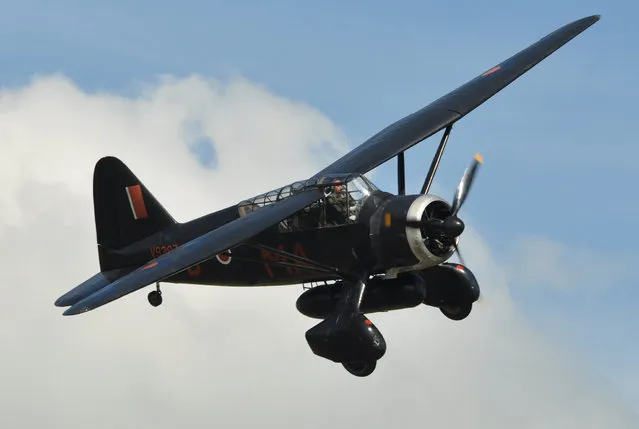
Westland Lysander Mk3A G-AZWT / V9367/MA-B – Flying Legends Airshow Duxford 2012. The Westland Lysander was a British army co-operation and liaison aircraft produced by Westland Aircraft used immediately before and during the Second World War. After becoming obsolete in the army co-operation role, the aircraft's exceptional short-field performance enabled clandestine missions using small, unprepared airstrips behind enemy lines to place or recover agents, particularly in occupied France with the French Resistance help. Like other British army air co-operation aircraft it was given the name of a mythical or legendary leader, in this case the Spartan general Lysander. In 1934 the Air Ministry issued Specification A.39/34 for an army co-operation aircraft to replace the Hawker Hector. Initially Hawker Aircraft, Avro and Bristol were invited to submit designs, but after some debate within the Ministry, a submission from Westland was invited as well. The Westland design, internally designated P.8, was the work of Arthur Davenport under the direction of “Teddy” Petter. It was Petter's second aircraft design and he spent considerable time interviewing Royal Air Force pilots to find out what they wanted from such an aircraft. The result of Petter's enquiries suggested that field of view, low-speed handling characteristics and STOL performance were the most important requirements. (Photo by Rob Lovesey)

Curtiss P-40F Warhawk BU 41-19841 VH-PIV /X-17 “Lee's Hope” – Flying Legends Airshow 2012 Duxford. The Fighter Collection’s Merlin-engined P-40F is one of only two left airworthy anywhere in the world. Manufactured at the Curtiss facility in Buffalo, New York in the autumn of 1942 and allocated Bu No. 41-19841. She was delivered by land to the Stockton In-Transit Depot in California for onward shipment in November, where she was then shipped to the Thirteenth Air Force in the Southwest Pacific on Christmas Eve 1942. Unfortunately her service career remains a mystery, but the only P-40Fs to see combat in the Pacific Theatre were flown by the 44th and the 68th Fighter Squadrons of the 347th Fighter Group in the Solomon Islands from November 1942 to October 1943. (Photo by Rob Lovesey)

Yakovlev Yak-3M “White 100” G-CGXG and Yakovlev Yak 3U – Flying Legends Airshow Duxford 2012. (Photo by Rob Lovesey)
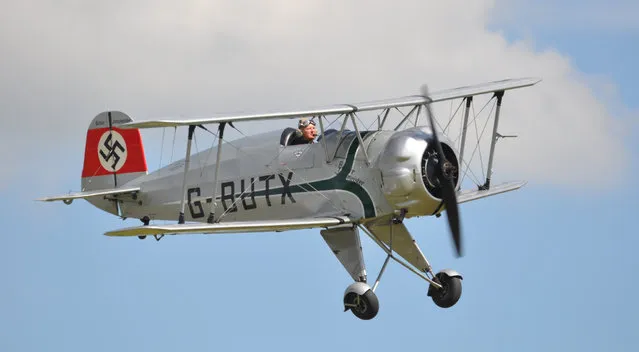
Bücker Bü 133 Jungmeister – Flying Legends Airshow Duxford 2012. The Bücker Bü 133 Jungmeister (Young master) was an advanced trainer of the Luftwaffe in the 1930s. It was a single-engine, single-seat biplane of wood and tubular steel construction and covered in fabric. The Bü 133 was a development of the Bücker Bü 131 Jungmann two-seat basic trainer. First flown in 1935 (by Luise Hoffmann, the first female works pilot in Germany), it was slightly smaller than the Bü 131. The prototype, D-EVEO, was powered by a 140 hp (104 kW) Hirth HM506 inverted, air-cooled inline-6 engine. The aircraft showed “astonishing agility” at its first public appearance, the 1936 International Aerobatic Championship at Rangsdorf, but the Bü 133A garnered no orders; only two Bü 133Bs, with 160 hp (119 kW) Siemens-Bramo Sh 14A radials, were built. (Photo by Rob Lovesey)

Junkers Ju 52 D-AQUI “Queen of the Skies” Luffhansia – Flying Legends Airshow Duxford 2012. The Junkers Ju 52 (nicknamed Tante Ju (“Auntie Ju”) and Iron Annie) was a German trimotor transport aircraft manufactured from 1932 to 1945. It saw both civilian and military service during the 1930s and 1940s. In a civilian role, it flew with over 12 air carriers including Swissair and Deutsche Luft Hansa as an airliner and freight hauler. In a military role, it flew with the Luftwaffe as a troop and cargo transport and briefly as a medium bomber. The Ju 52 continued in postwar service with military and civilian air fleets well into the 1980s. (Photo by Rob Lovesey)

Avro Lancaster of the Battle of Britain Memorial Flight – Flying Legends Airshow Duxford 2012. The Avro Lancaster is the most famous and successful RAF heavy bomber of World War Two. It is a legend that lives on today and the contribution made by the aircraft and its crews to the freedom of our nation will, hopefully, never be forgotten. The prototype Lancaster took to the air for its first flight from Woodford, Manchester, on 9th January 1941; the first production Lancaster flew later that year on 31st October. The first RAF unit to receive the new aircraft for operations (on Christmas Eve 1941) was No 44 Squadron at Waddington, quickly followed by 97 Squadron at Woodhall Spa. The performance of the Lancaster was simply outstanding. It could carry a maximum bomb load of 22,000 lb, its maximum level speed with a full load at 15,000 feet was 275 mph and it could cruise routinely at altitudes above 20,000ft at a range speed of 200 mph. With a full bomb load the aircraft had a range in excess of 1,500 miles. The Lancaster’s performance, its ruggedness, reliability and to many its sheer charisma, endeared it to its crews who were proud to fly this famous thoroughbred. (Photo by Rob Lovesey)

Boeing B-17G Flying Fortress (299P) G-BEDF / 124485/DF-A “Sally B” “Memphis Belle” – Flying Legends Airshow 2012 Duxford. Sally B is the name of an airworthy 1945-built Boeing B-17G Flying Fortress. It was delivered to the United States Army Air Force (USAAF) on 19 June 1945 as 44-85784; after being converted to both a TB-17G and then an EB-17G it was struck off charge in 1954. In 1975 the Institut Géographique National in France bought the plane for use as a survey aircraft. In 1975 it moved to England to be restored to wartime condition as a memorial to the USAAF B-17 airmen who lost their lives in the European theatre. It is based at the Imperial War Museum Duxford, England. The Sally B was used in the film Memphis Belle as one of 5 flying B-17s needed for various film scenes, and it was used to replicate the real Memphis Belle in one scene. Half of the aircraft is still in the Memphis Belle livery. (Photo by Rob Lovesey)

Republic P-47G Thunderbolt 42-25068 “Snafu” G-CDVX (WZ-D) – The Fighter Collection – Flying Legends Airshow Duxford 2012. The Fighter Collection “Razorback” P-47G is one of only two Curtiss-built examples left in the world. She was the 129th P-47G built at the Curtiss facility in Buffalo, New York in early 1944. The fighter was accepted by the USAAF in September 1944 and transferred to the Third Air Force at Tallahassee, Florida. It was here that she was re-designated as a TP-47G to reflect the training role she undertook with a number of Advanced Fighter Transition Units. The Fighter Collection P-47G was struck from the USAAF inventory in late June 1945 and was eventually passed to the Aero Industries Technical Institute at Oakland Airport, California. It was here that she taught hydraulic and electrical systems to aeronautical students until 1952 when she was bought by Jack Hardwick, a former Cleveland National Air Race pilot, who rented her out in 1953 to Allied Artists for ground scenes in the film Fighter Attack. (Photo by Rob Lovesey)
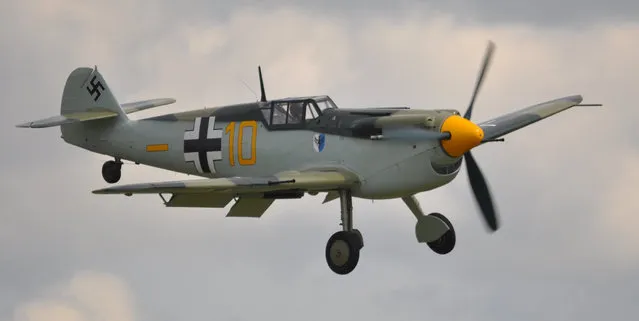
Messerschmitt Bf 109 – Flying Legends Airshow Duxford 2012. The Messerschmitt Bf 109, often called Me 109, was a German World War II fighter aircraft designed by Willy Messerschmitt and Robert Lusser during the early to mid 1930s. It was one of the first truly modern fighters of the era, including such features as all-metal monocoque construction, a closed canopy, a retractable landing gear, and was powered by a liquid-cooled, inverted-V12 aero engine. The Bf 109 first saw operational service during the Spanish Civil War and was still in service at the dawn of the jet age at the end of World War II, during which time it was the backbone of the Luftwaffe's fighter force. From the end of 1941 the Bf 109 was supplemented by the Focke-Wulf Fw 190. (Photo by Rob Lovesey)

Supermarine 359 Spitfire HF8C Mk VIIIC D-FEUR / MT928/ZX-M – Flying Legends Airshow Duxford 2012. The Supermarine Spitfire was a British single-seat fighter aircraft that was used by the Royal Air Force and many other Allied countries throughout the Second World War. The Spitfire continued to be used as a front line fighter and in secondary roles into the 1950s. It was produced in greater numbers than any other British aircraft and was the only British fighter in production throughout the war. (Photo by Rob Lovesey)

Supermarine Spitfire Mk 1A G-MKIA / P9374 – Flying Legends Airshow Duxford 2012. The Supermarine Spitfire was a British single-seat fighter aircraft that was used by the Royal Air Force and many other Allied countries throughout the Second World War. The Spitfire continued to be used as a front line fighter and in secondary roles into the 1950s. It was produced in greater numbers than any other British aircraft and was the only British fighter in production throughout the war. (Photo by Rob Lovesey)

Messerschmitt Bf 109 – Flying Legends Airshow 2012 Duxford. The Messerschmitt Bf 109, often called Me 109, was a German World War II fighter aircraft designed by Willy Messerschmitt and Robert Lusser during the early to mid 1930s. It was one of the first truly modern fighters of the era, including such features as all-metal monocoque construction, a closed canopy, a retractable landing gear, and was powered by a liquid-cooled, inverted-V12 aero engine. The Bf 109 first saw operational service during the Spanish Civil War and was still in service at the dawn of the jet age at the end of World War II, during which time it was the backbone of the Luftwaffe's fighter force. From the end of 1941 the Bf 109 was supplemented by the Focke-Wulf Fw 190. (Photo by Rob Lovesey)

The Flying Bull's P-38 Lightning N25Y / 13 – Flying Legends Airshow Duxford 2012. The Lockheed P-38 Lightning was a World War II American fighter aircraft built by Lockheed. Developed to a United States Army Air Corps requirement, the P-38 had distinctive twin booms and a single, central nacelle containing the cockpit and armament. Named “fork-tailed devil” by the Luftwaffe and “two planes, one pilot” by the Japanese, the P-38 was used in a number of roles, including dive bombing, level bombing, ground-attack, photo reconnaissance missions, and extensively as a long-range escort fighter when equipped with drop tanks under its wings. (Photo by Rob Lovesey)
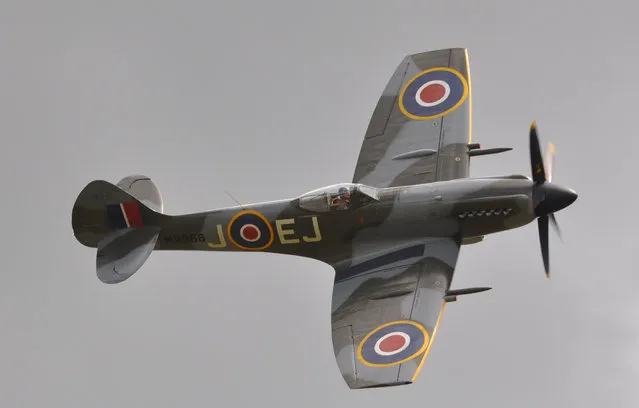
Supermarine 379 Spitfire Mk XIV FR14E G-SPIT / MV268/JE-J – Flying Legends Airshow Duxford 2012. Built at the end of 1944 at Keevil, this Spitfire Mk XIV was stored by the RAF until early 1945. It was sent, from 33MU at RAF Lyneham, to India where details of whatever service she saw have been lost in the mists of time – and the Royal Indian Air Force records system. (Photo by Rob Lovesey)
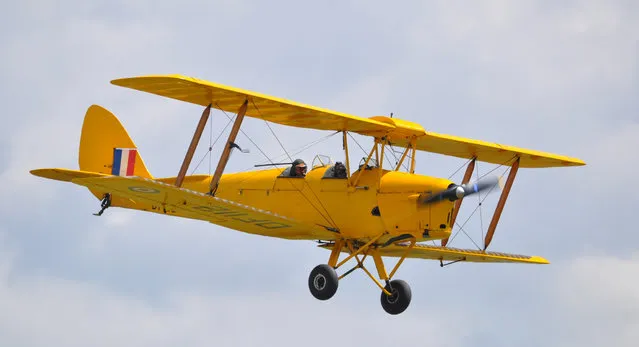
De Havilland DH-82A Tiger Moth II G-ANRM / DF112 Classic Wings Duxford – Flying Legends Airshow Duxford 2012. The de Havilland DH 82 Tiger Moth is a 1930s biplane designed by Geoffrey de Havilland and was operated by the Royal Air Force (RAF) and others as a primary trainer. The Tiger Moth remained in service with the RAF until replaced by the de Havilland Chipmunk in 1952, when many of the surplus aircraft entered civil operation. Many other nations used the Tiger Moth in both military and civil applications, and it remains in widespread use as a recreational aircraft in many countries. (Photo by Rob Lovesey)

North American Aviation CCF T-6H Harvard Mk 4M G-BJST / KF729 – Classic Wings Duxford – Flying Legends Airshow Duxford 2012. The North American Aviation T-6 Texan was a single-engine advanced trainer aircraft used to train pilots of the United States Army Air Forces, United States Navy, Royal Air Force and other air forces of the British Commonwealth during World War II and into the 1950s. (Photo by Rob Lovesey)

Hawker Sea Fury T20 – VX281 VL120 – Flying Legends Airshow Duxford 2012. The Sea Fury was the Fleet Air Arm's last piston-engined fighter to serve in front-line Squadrons. The prototype Sea Fury first flew on 21 February 1945 and carried out deck landing trials in HMS Ocean in October of that year. The first production aircraft (Mk.F.10) flew on 15 August 1946 and the first Squadron, No.807, re-equipped with F.10s at the Royal Naval Air Station Culdrose in late 1947. The first Squadron to fly with the FB.11 variant, No.802, re-formed in May 1948. In all, fifty Sea Fury F.10s were built, followed by 615 Sea Fury FB.11s, the last of which came off the production line in November 1952. (Photo by Rob Lovesey)

De Havilland DH-89A Dominie G-AKIF – Flying Legends Airshow Duxford 2012. The de Havilland DH.89 Dragon Rapide was a 1930s British short-haul biplane passenger airliner. In late 1933, the Dragon Rapide was designed at the de Havilland company as a faster and more comfortable successor to the DH.84 Dragon. It was in effect a twin-engined, scaled-down version of the four-engined DH.86 Express. It shared many common features with the larger aircraft, including its tapered wings, streamlined fairings and the Gipsy Six engine, but it demonstrated none of the operational vices of the larger aircraft, and went on to become perhaps the most successful British-built short-haul commercial passenger aircraft of the 1930s. (Photo by Rob Lovesey)

North American TF-51D - NX251RJ / CY-D 44-84847 “Miss Velma” – Flying Legends Airshow 2012 Duxford. Built too late to see combat service in World War Two, P-51D 44-84847 was one of the last Mustangs constructed at North American Aviation’s Dallas, Texas, plant. Details of her post war service career are limited, but there is photographic evidence, from September 1951, of her serving with the 45th Tactical Reconnaissance Squadron at Kimpo, South Korea, during the Korean War. (Photo by Rob Lovesey)

Yakovlev Yak-3M “White 100” G-CGXG – Flying Legends Airshow Duxford 2012. Yak-3M G-CGXG was assembled at Strela in Orenburg (700 miles south-east of Moscow on the Russian-Kazakh border) in the early 1990s. It was the result of a co-operation between the Yakovlev Design Bureau, Strela and Flight Magic, Santa Monica, California. Its design is based as closely as possible on the wartime Yak-3, but utilises an all-metal structure. Strela was formed from the original Zavod (Factory) 47 in Leningrad (hence the 047 in the serial number). This factory was evacuated to Chkalov in 1941, a suburb of Orenburg. In 1958 the factory's designation was changed to Strela. Strela manufactured strategic missiles until 1998, and now make a host of other products. G-CGXG is powered by an Allison V-1710 engine as there is currently no single working Klimov engine available. Both the Klimov and the Allison V-1710 are liquid cooled piston V-12 engines with very similar dimensions and power. (Photo by Rob Lovesey)

The Flying Bull's P-38 Lockheed Lightning N25Y / 13 – Red Bull – Flying Legends Airshow 2012 Duxford (Photo by Rob Lovesey)
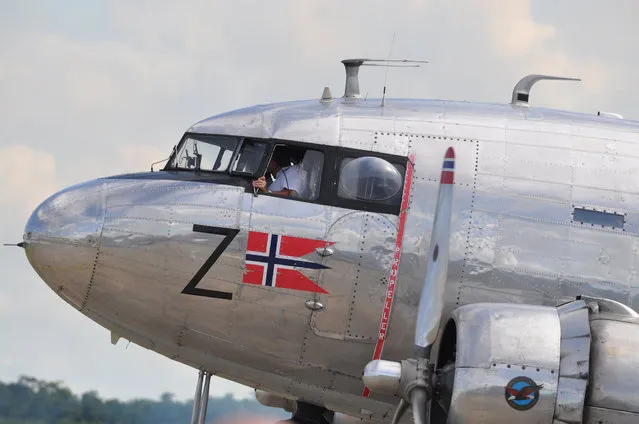
Dakota Norway Douglas DC-3C LN-WND – Flying Legends Airshow 2021 Duxford (Photo by Rob Lovesey)

Dakota Norway Douglas DC-3C LN-WND – Flying Legends Airshow 2021 Duxford. The Douglas DC-3 is an American fixed-wing propeller-driven airliner, the speed and range of which revolutionized air transport in the 1930s and 1940s. Its lasting impact on the airline industry and World War II makes it one of the most significant transport aircraft ever made. The major military version was designated the C-47 Skytrain, of which more than 10,000 were produced. Many DC-3 / C-47s are still used in all parts of the world. The DC-3 was the culmination of a development effort that originated out of an inquiry from Transcontinental and Western Airlines (TWA) to Donald Douglas. TWA's rival in transcontinental air service, United Airlines, was inaugurating service with the Boeing 247 and Boeing refused to sell any 247s to other airlines until United's order for 60 aircraft had been filled. TWA asked Douglas to design and build an aircraft that would enable TWA to compete with United. Douglas' resulting design, the 1933 DC-1, was promising, and led to the DC-2 in 1934. While the DC-2 was a success, there was still room for improvement. (Photo by Rob Lovesey)

Fairey Swordfish Mk II - LS326 “City of Liverpool” Royal Navy Historical Flight – Flying Legends Airshow Duxford 2012. Fairey Swordfish Mk II – LS326 “City of Liverpool” Royal Navy Historical Flight – Flying Legends Airshow Duxford 2012. The Swordfish evolved from the prototype Fairey TSR.II (Torpedo Spotter Reconnaissance), designed by Marcel Lobelle and HE Chaplin of the Fairey Aviation Company Ltd., first flew in 1934 and entered service with No.825 Squadron in 1936. In all, 2391 aircraft were built, the first 692 machines by Fairey Aviation and the remainder under licence by Blackburn Aircraft Company at their works at Sherburn-in-Elmet and Brough, Yorkshire. In service the Blackburn-built aircraft became unofficially known as “Blackfish”. Perhaps the most remarkable aspect of this very distinguished aircraft was its longevity. Although by all normal standards it was already obsolete at the outbreak of WW2, it confounded everyone by remaining in operational service throughout the whole of the war, and thereby gained the distinction of being the last British bi-plane to see active service. Indeed, it outlasted its intended replacement, the Albacore, which disappeared from front-line service in 1943. (Photo by Rob Lovesey)
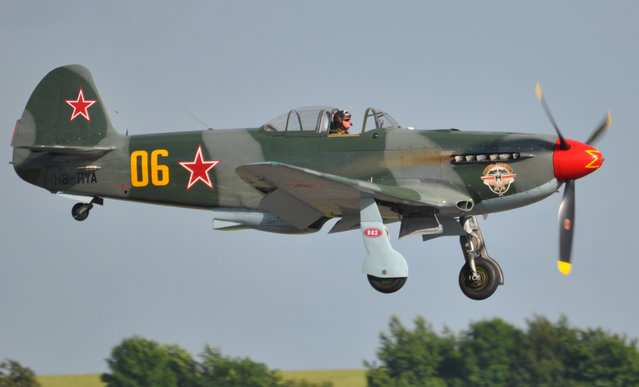
Yakovlev Yak-9UM HB-RYA/06 The Fighter Association – Flying Legends Airshow 2012 Duxford. The Yakovlev Yak-9 was a single-engine fighter aircraft used by the Soviet Union in World War II and after. Fundamentally a lighter development of the Yak-7 with the same armament, it arrived at the front at the end of 1942. The Yak-9 had a lowered rear fuselage decking and all-around vision canopy. Its lighter airframe gave the new fighter a flexibility that previous models had lacked. The pilots who flew it regarded its performance as comparable with those of the Messerschmitt Bf 109G and Focke-Wulf Fw 190A-3/A-4. The Yak-9 was the most mass-produced Soviet fighter of all time. It remained in production from 1942 to 1948, with 16,769 built (14,579 during the war). It was the first Soviet aircraft to shoot down a Messerschmitt Me 262 jet. It was used by North Korea in the Korean War. (Photo by Rob Lovesey)
20 Nov 2012 12:10:00,
post received
0 comments
